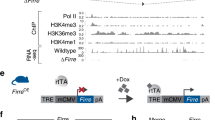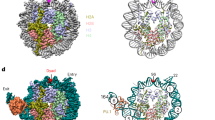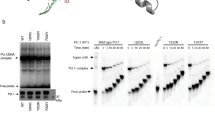Abstract
Tumor necrosis factor (TNF) mediates a variety of biological activities including cell proliferation, differentiation and programmed cell death. The specific response to TNF depends upon cell type and reflects the presence of specific regulatory proteins that participate in the TNF response pathway. TNF signal transduction is mediated by TRAF2 which binds the TNF Receptor2 (TNFR2) and activates NFκB. We previously identified a gene Pw1, which encodes a large zinc-finger containing protein1. We have determined that Pw1 is identical to Peg3, a paternally expressed gene of unknown function2 (and will therefore be referred to as Peg3 throughout this text). We report here that Peg3 associates specifically with TRAF2 but not with other TRAF family members. Peg3 expression activates NFκB via IκB-NFκB dissociation and acts synergistically with TRAF2. Transfection of a truncated Peg3 containing the TRAF2 interaction site, abolishes NFκB activation by TRAF2 and/or TNF. We conclude that Peg3 is a regulator of the TNF response. These data reveal the involvement of an imprinted gene in this pathway.
This is a preview of subscription content, access via your institution
Access options
Subscribe to this journal
Receive 12 print issues and online access
$209.00 per year
only $17.42 per issue
Buy this article
- Purchase on Springer Link
- Instant access to full article PDF
Prices may be subject to local taxes which are calculated during checkout
Similar content being viewed by others
References
Relaix, F. et al. Pw1, a novel zinc-finger gene implicated in the myogenic and neuronal lineages. Dev. Biol. 177, 383–396 (1996).
Kuroiwa, Y. et al. Peg3 imprinted gene on proximal chromosome 7 encodes for a zinc finger protein. Nature Genet. 12, 186–190 (1996).
Rothe, M., Sarma, V., Dixit, V.M. & Goeddel, D.V. TRAF2-mediated activation of NF-kappa B by TNF receptor 2 and CD40. Science 269, 1424–1427 (1995).
Hsu, H., Shu, H.B., Pan, M.G. & Goeddel, D.V. TRADD-TRAF2 and TRADD-FADD interactions define two distinct TNF receptor 1 signal transduction pathways. Cell 84, 299–308 (1996).
Stancovski, I. & Baltimore, D. NF-κB Activation: The IκB Kinase Revealed? Cell 91, 299–302 (1997).
Brown, S.D., Chartier, F., Johnson, K. & Cavanna, J.S. Mapping the Hrc gene to proximal mouse chromosome 7: delineation of a conserved linkage group with human 19q. Genomics 18, 459–461 (1993).
Jansen, G. et al. No imprinting involved in the expression of DM-kinase mRNAs in mouse and human tissues. Hum. Mol. Genet. 2, 1221–1227 (1993).
Rubio, M.P. et al. The putative glioma tumor suppressor gene on chromosome 19q maps between APOC2 and HRC. Cancer Res. 54, 4760–4763 (1994).
Yong, W.H. et al. Chromosome 19q deletions in human gliomas overlap telomeric to D19S219 and may target a 425kb region centromeric to D19S112. J. Neuropathol. Exp. Neurol. 54, 622–666 (1995).
Cao, Z., Xiong, J., Takeuchi, M., Kurama, T. & Goeddel, D.V. TRAF6 is a signal transducer for interleukin-1. Nature 383, 443–446 (1996).
Cheng, G. et al. Involvement of CRAF1, a relative of TRAP, in CD40 signaling. Science 267, 1494–1498 (1995).
Hu, H.M., O'Rourke, K., Boguski, M.S. & Dixit, V.M. A novel RING finger protein interacts with the cytoplasmic domain of CD40. J. Biol. Chem. 269, 30069–30072 (1994).
Nakano, H. et al. TRAF5, an activator of NF-kappaB and putative signal transducer for the lymphotoxin-beta receptor. J. Biol. Chem. 271, 14661–14664 (1996).
Regnier, C.H. et al. Presence of a new conserved domain in CART1, a novel member of the tumor necrosis factor receptor-associated protein family, which is expressed in breast carcinoma. J. Biol. Chem. 270, 25715–25721 (1995).
Rothe, M., Wong, S.C., Henzel, W.J. & Goeddel, D.V. A novel family of putative signal transducers associated with the cytoplasmic domain of the 75 kDa tumor necrosis factor receptor. Cell 78, 681–692 (1994).
Song, H.Y. & Donner, D.B. Association of a RING finger protein with the cytoplasmic domain of the human type-2 tumour necrosis factor receptor. J. Biochem. 309, 825–829 (1995).
Rothe, M. et al. I-TRAF is a novel TRAF-interacting protein that regulates TRAF-mediated signal transduction. Proc. Natl. Acad. Sci. USA. 93, 8241–8246 (1996).
Takeuchi, M., Rothe, M. & Goeddel, D.V. Anatomy of TRAF2 : Distinct domains for Nuclear Factor-κB activation and association with tumor necrosis factor signaling proteins. J. Biol. Chem. 271, 19935–19942 (1996).
Malinin, N.L., Boldin, M.P., Kovalenko, A.V. & Wallach, D. MAP3K-related kinase involved in NF-kappaB induction by TNF, CD95 and IL-1. Nature 385, 540–544 (1997).
Duyao, M., Buckler, A.J. & Sonenshein, G.E. Interaction of an NF-κB like factor with a site upstream of the c-myc promoter. Proc. Natl. Acad. Sci. USA 87, 4727–4731 (1990).
Brown, K., Gerstberger, S., Carlson, L., Franzoso, G. & Siebenlist, U. Control of I kappa B-alpha proteolysis by site-specific, signal-induced phosphorylation. Science 267, 1485–1488 (1995).
Hermeking, H. & Eick, D. Mediation of c-myc-induced apoptosis by p53. Science 165, 1091–1093 (1994).
Wang, C.Y., Mayo, M.W. & Baldwin, A.S.J. TNF- and cancer therapy-induced apoptosis: potentiation by inhibition of NF-kappaB. Science 274, 784–787 (1996).
Van Antwerp, D.J., Martin, S.J., Kafri, T., Green, D.R. & Verma, I.M. Suppression of TNF-alpha-induced apoptosis by NF-kappaB. Science 27, 787–789 (1996).
Beg, A.A. & Baltimore, D. An essential role for NF-kappaB in preventing TNF-alpha-induced cell death. Science 274, 782–784 (1996).
Hsu, H., Huang, J., Shu, H.B., Baichwal, V. & Goeddel, D.V. TNF-dependent recruitment of the protein kinase RIP to the TNF receptor-1 signaling complex. Immunity 4, 387–396 (1996).
Stanger, B.Z., Leder, P., Lee, T.H., Kim, E. & Seed, B. RIP: a novel protein containing a death domain that interacts with Fas/APO-1 (CD95) in yeast and causes cell death. Cell 81, 513–523 (1995).
Ting, A.T., Pimentel-Muinos, F.X. & Seed, B. RIP mediates tumor necrosis factor receptor 1 activation of NF-kappaB but not Fas/APO-1-initiated apoptosis. EMBO J. 15, 6189–6196 (1996).
Kitson, J. et al. A death-domain-containing receptor that mediates apoptosis. Nature 384, 372–375 (1996).
Chinnaiyan, A. et al. Signal transduction by DR3, a death domain-containing receptor related to TNFR-1 and CD95. Science 274, 990–992 (1996).
Beutler, B. et al. Identity of tumour necrosis factor and the macrophage-secreted factor cachectin. Nature 316, 552–554 (1985).
Neumann, B., Kubicka, P. & Barlow, D.P. Characteristics of imprinted genes. Nature Genet. 9, 12–13 (1995).
Hurst, L.D., McVean, G. & Moore, T. Imprinted genes have few and small introns Nature Genet. 12, 234–237 (1996).
Chen, C. & Okayama, H. High-efficiency transformation of mammalian cells by plasmid DNA. Mol. Cell. Biol. 7, 2745–2752 (1987).
Seed, B. & Sheen, J.Y. A simple phase-extraction assay for chloramphenicol acetyltransferase activy. Gene 67, 271–277 (1988).
Lee, F.S., Hagler, J., Chen, Z.J. & Maniatis, T. Activation of the IkappaB alpha kinase complex by MEKK1, a kinase of the JNK pathway. Cell 88, 213–222 (1997).
Author information
Authors and Affiliations
Corresponding author
Rights and permissions
About this article
Cite this article
Relaix, F., Wei, XJ., Wu, X. et al. Peg3/Pw1 is an imprinted gene involved in the TNF-NFκB signal transduction pathway. Nat Genet 18, 287–291 (1998). https://doi.org/10.1038/ng0398-287
Received:
Accepted:
Issue Date:
DOI: https://doi.org/10.1038/ng0398-287
This article is cited by
-
Hypoxia promotes a perinatal-like progenitor state in the adult murine epicardium
Scientific Reports (2022)
-
The imprinted gene Pw1/Peg3 regulates skeletal muscle growth, satellite cell metabolic state, and self-renewal
Scientific Reports (2018)
-
Loss of miR-514a-3p regulation of PEG3 activates the NF-kappa B pathway in human testicular germ cell tumors
Cell Death & Disease (2017)
-
PW1/Peg3 expression regulates key properties that determine mesoangioblast stem cell competence
Nature Communications (2015)
-
Contributions of Muscle-Resident Progenitor Cells to Homeostasis and Disease
Current Molecular Biology Reports (2015)



